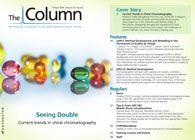Waxing Lyrical: Analyzing VOCs in Human Cerumen
A team of scientists based in the US has used solid–phase microextraction (SPME) and gas chromatography–mass spectrometry (GC–MS) to provide the first analysis of volatile organic compounds (VOCs) present in human earwax (cerumen).1
A team of scientists based in the US has used solid-phase microextraction (SPME) and gas chromatography–mass spectrometry (GC–MS) to provide the first analysis of volatile organic compounds (VOCs) present in human earwax (cerumen).1
There are between 1000 and 2000 ceruminous glands in the ear, keeping the eardrum lubricated, waterproof, and cleaning the external auditory canal. Cerumen also has antibacterial properties and can reduce the viability of a range of bacteria. The team also investigated and compared cerumen prof les of subjects of East Asian and Caucasian descent. Cerumen from Caucasian subjects is a wet, yellow-brown colour; while East Asian subjects have a dry, white wax. Lead author of the study, Katharine Prokop-Prigge, told The Column: “Earwax, until now, has been a little-studied human secretion. We have found important information contained in human earwax, specifically information about the ethnicity of a person simply by looking in his ears.”
The team sampled the headspace of earwax samples from 16 male subjects by using SPME. The earwax sample was first transferred to glass vials and incubated at body temperature for 30 min. This allowed the release of volatiles into the headspace of the vial. The SPME fibre was then exposed in the vial’s headspace for an additional 30 min. The compounds adsorbed onto the fibre were separated and identified using GC–MS. While the analysis was relatively straightforward, Prokop-Prigge revealed to The Column that one issue arose during the course of the experiment. “The different earwax types, wet vs. dry, provided very different matrices for dissolving and subsequently releasing an internal standard. To get around this, we employed an external standard injected on the GC–MS prior to each sample to account for daily variation in GC–MS responses”, she said.
The principal odourants emitted were C2-to-C6 acids. The study found that the two groups emitted many of the same VOCs but the relative amounts were found to be greater in the Caucasian group in relation to the East Asian results. Prokop-Prigge concluded: “Our lab has studied human odours and the information they contain for years. In this study, we wanted to examine ‘a new frontier of human odour’ and possibly uncover unique information about a person by examining his/her earwax.” - K.M.
Reference
1. K.A. Prokop-Prigge et al., Journal of Chromatography B, http://dx.doi.org/10.1016/j.jchromb.2014.01.043 (2014).
This article first appeared in The Column. Click to view and print this issue>>

Measuring Vitamin K1 Concentrations in Dogs with Chronic Enteropathy Using LC–MS/MS
May 14th 2025A joint study between the University of Tennessee (Knoxville, Tennessee) and the University of Pennsylvania School of Veterinary Medicine (Philadelphia, Pennsylvania) compared directly measured vitamin K1 (vitK1) concentrations in healthy dogs and dogs with chronic enteropathy (CE) using liquid chromatography tandem mass spectrometry (LC–MS/MS); they also investigated whether supplementation of vitK1 in dogs with CE would significantly increase vitK1 concentrations.
HPLC 2025 Preview: Fundamentally Speaking (Part 2)
May 14th 2025Michael Lämmerhofer from the Institute of Pharmaceutical Sciences, University of Tübingen, Germany, spoke to JFK Huber Lecture Award winner of 2024 Torgny Fornstedt, professor in analytical chemistry and leader of the Fundamental Separation Science Group, Karlstad University, Sweden, about his pioneering work in high performance liquid chromatography (HPLC) with a focus on fundamentals, ion-pair chromatography, and oligonucleotide applications.

.png&w=3840&q=75)

.png&w=3840&q=75)



.png&w=3840&q=75)



.png&w=3840&q=75)










